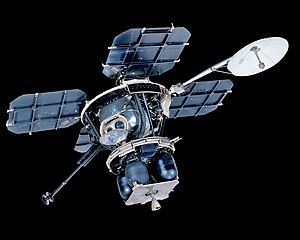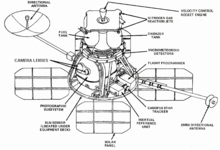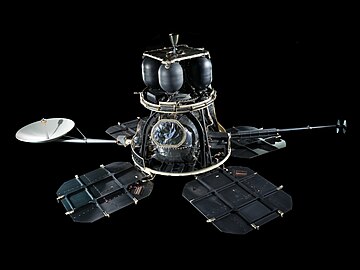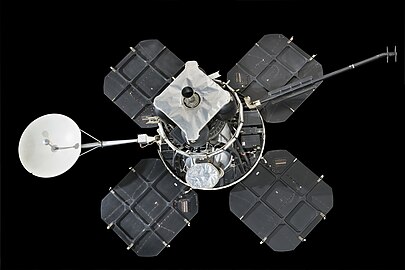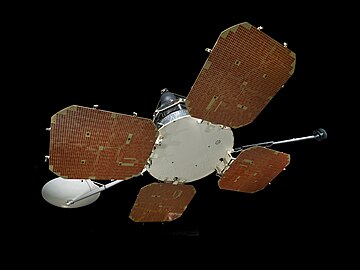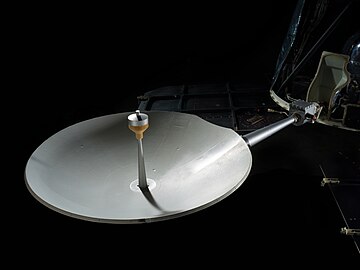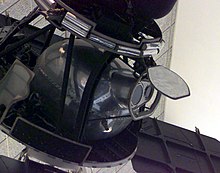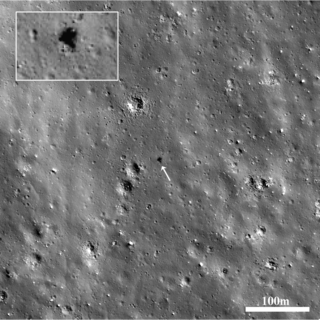
Surveyor 7 was the seventh and last lunar lander of the American uncrewed Surveyor program sent to explore the surface of the Moon. A total of 21,091 pictures were transmitted to Earth.

Surveyor 3 was the third lander of the American uncrewed Surveyor program sent to explore the surface of the Moon in 1967. It was the first mission to carry a surface-soil sampling-scoop.
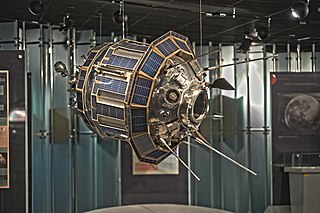
Luna 3, or E-2A No.1 was a Soviet spacecraft launched in 1959 as part of the Luna programme. It was the first mission to photograph the far side of the Moon and the third Soviet space probe to be sent to the neighborhood of the Moon. Though it returned rather poor pictures, the historic, never-before-seen views of the far side of the Moon caused excitement and interest when they were published around the world, and a tentative Atlas of the Far Side of the Moon was created after image processing improved the pictures.

Surveyor 1 was the first lunar soft-lander in the uncrewed Surveyor program of the National Aeronautics and Space Administration. This lunar soft-lander gathered data about the lunar surface that would be needed for the crewed Apollo Moon landings that began in 1969. The successful soft landing of Surveyor 1 on the Ocean of Storms was the first by an American space probe on any extraterrestrial body, occurring on the first attempt and just four months after the first soft Moon landing by the Soviet Union's Luna 9 probe.

The Ranger program was a series of uncrewed space missions by the United States in the 1960s whose objective was to obtain the first close-up images of the surface of the Moon. The Ranger spacecraft were designed to take images of the lunar surface, transmitting those images to Earth until the spacecraft were destroyed upon impact. A series of mishaps, however, led to the failure of the first six flights. At one point, the program was called "shoot and hope". Congress launched an investigation into "problems of management" at NASA Headquarters and Jet Propulsion Laboratory. After two reorganizations of the agencies, Ranger 7 successfully returned images in July 1964, followed by two more successful missions.
Luna 12 was an unmanned space mission of the Luna program, also called Lunik 12.

Surveyor 2 was to be the second lunar lander in the uncrewed American Surveyor program to explore the Moon. It was launched September 20, 1966 from Cape Kennedy, Florida aboard an Atlas-Centaur rocket. A mid-course correction failure resulted in the spacecraft losing control. Contact was lost with the spacecraft at 9:35 UTC, September 22.

Surveyor 6 was the sixth lunar lander of the American uncrewed Surveyor program that reached the surface of the Moon. Surveyor 6 landed on the Sinus Medii. A total of 30,027 images were transmitted to Earth.

The 1966 Lunar Orbiter 1 robotic spacecraft mission, part of NASA's Lunar Orbiter program, was the first American spacecraft to orbit the Moon. It was designed primarily to photograph smooth areas of the lunar surface for selection and verification of safe landing sites for the Surveyor and Apollo missions. It was also equipped to collect selenodetic, radiation intensity, and micrometeoroid impact data.
The 1966 Lunar Orbiter 2 robotic spacecraft mission, part of the Lunar Orbiter Program, was designed primarily to photograph smooth areas of the lunar surface for selection and verification of safe landing sites for the Surveyor and Apollo missions. It was also equipped to collect selenodetic, radiation intensity, and micrometeoroid impact data.

The Lunar Orbiter 3 was a spacecraft launched by NASA in 1967 as part of the Lunar Orbiter Program. It was designed primarily to photograph areas of the lunar surface for confirmation of safe landing sites for the Surveyor and Apollo missions. It was also equipped to collect selenodetic, radiation intensity, and micrometeoroid impact data.

Lunar Orbiter 4 was a robotic U.S. spacecraft, part of the Lunar Orbiter Program, designed to orbit the Moon, after the three previous orbiters had completed the required needs for Apollo mapping and site selection. It was given a more general objective, to "perform a broad systematic photographic survey of lunar surface features in order to increase the scientific knowledge of their nature, origin, and processes, and to serve as a basis for selecting sites for more detailed scientific study by subsequent orbital and landing missions". It was also equipped to collect selenodetic, radiation intensity, and micrometeoroid impact data.

Lunar Orbiter 5, the last of the "Lunar Orbiter series", was designed to take additional Apollo and Surveyor landing site photography and to take broad survey images of unphotographed parts of the Moon's far side. It was also equipped to collect selenodetic, radiation intensity, and micrometeoroid impact data and was used to evaluate the Manned Space Flight Network tracking stations and Apollo Orbit Determination Program.

A Moon landing or lunar landing is the arrival of a spacecraft on the surface of the Moon. This includes both crewed and robotic missions. The first human-made object to touch the Moon was the Soviet Union's Luna 2, on 13 September 1959.

During the 1971 Apollo 15 mission to the Moon, and its three days of exploration on the lunar surface by David Scott and James Irwin, Command Module Pilot (CMP) Al Worden had a busy schedule of observations. Apollo 15 was the first mission to carry the Scientific Instrument Module (SIM) bay, which contained a panoramic camera, gamma ray spectrometer, mapping camera, laser altimeter and mass spectrometer. Worden had to operate the shutter and lenses on the cameras and turn on and off the various instruments. During the coast back to Earth, he would perform an EVA to retrieve film cassettes from the cameras.

The Apollo program used several television cameras in its space missions in the late 1960s and 1970s; some of these Apollo TV cameras were also used on the later Skylab and Apollo–Soyuz Test Project missions. These cameras varied in design, with image quality improving significantly with each successive model. Two companies made these various camera systems: RCA and Westinghouse. Originally, these slow-scan television (SSTV) cameras, running at 10 frames per second (fps), produced only black-and-white pictures and first flew on the Apollo 7 mission in October 1968. A color camera – using a field-sequential color system – flew on the Apollo 10 mission in May 1969, and every mission after that. The color camera ran at the North American standard 30 fps. The cameras all used image pickup tubes that were initially fragile, as one was irreparably damaged during the live broadcast of the Apollo 12 mission's first moonwalk. Starting with the Apollo 15 mission, a more robust, damage-resistant camera was used on the lunar surface. All of these cameras required signal processing back on Earth to make the frame rate and color encoding compatible with analog broadcast television standards.

Earthrise is a photograph of Earth and part of the Moon's surface that was taken from lunar orbit by astronaut William Anders on December 24, 1968, during the Apollo 8 mission. Nature photographer Galen Rowell described it as "the most influential environmental photograph ever taken".

The Lunar Reconnaissance Orbiter (LRO) is a NASA robotic spacecraft currently orbiting the Moon in an eccentric polar mapping orbit. Data collected by LRO have been described as essential for planning NASA's future human and robotic missions to the Moon. Its detailed mapping program is identifying safe landing sites, locating potential resources on the Moon, characterizing the radiation environment, and demonstrating new technologies.

The Lunar Orbiter Image Recovery Project (LOIRP) is a project to digitize the original analog data tapes from the five Lunar Orbiter spacecraft that were sent to the Moon in 1966 and 1967; it is funded by NASA, SkyCorp, SpaceRef Interactive, and private individuals.
